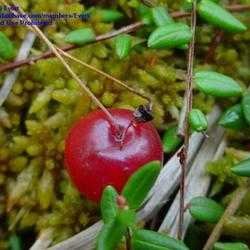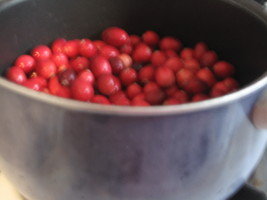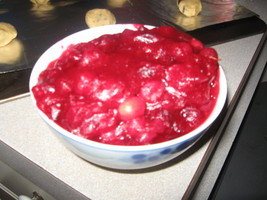





The humble northern cranberry has been associated with Thanksgiving and turkey since 1620. It is said that Native Americans first taught the hungry Pilgrims how to eat this acidic berry. Now cranberry sauce is a important part of Christmas in English-speaking countries everywhere, as well as a necessary part of Canadian and American Thanksgivings. Cranberries have been touted recently with having innumerable health benefits. To me, cranberries are a local industry and a delicious easy-to-make side dish.
I live in Massachusetts, not 20 miles from Plymouth Rock. All I heard about growing up were Pilgrims and Pocahantas, wild turkeys and how the English settlers learned to plant corn, beans and squash together. Once I grew up and had my own kitchen, I learned that cranberry sauce didn't just come out of a can and that there are tons of delicious ways to use cranberries (Vaccinium oxycoccos) in recipes.
Everyone knows how to string cranberries to make a garland for the Christmas tree. (If little ones are helping, use a darning needle and waxed dental floss or colored yarn. If speed is of the essence, use a long, sharp needle, like a beading needle, or thread straight onto narrow guage wire. In either case, you may intersperse with popcorn, cinnamon sticks, pine cones, acorns with a tiny hole drilled into them, or beads, or just use cranberries. Hang inside on the tree or outside for birds and critters to enjoy. Use shellac or varnish if you want them not to turn into dried cranberries, but not if you're planning for ANY living thing to eat them.) Cranberries can also be used in other crafty ways, particularly when fully red and ripe. For instance, if you're having a party, impress your guests by freezing a whole cranberry inside each ice cube. As each one melts it will release a tangy burst of flavor!
In my experience, however, color does not affect flavor. (White cranberry juice is made from cranberries that are not fully ripe, and hence, not as tart.) Since cranberries ripen for real sometime between September and November, by the time they're for sale around here as fresh berries, they usually don't all have the characteristic bright red color. They are paler, and don't look as robust as one might expect. (The ones in the picture above, courtesy of The Cranberry Institute, look cooked to me. The ones in my pot below are what they normally look like out of the package in November.) But they still taste just as good. Use cranberries fresh or frozen; no need to defrost them first. Unlike blueberries or apples, cranberries don't get mushy when you add them to muffins or breads. I'll give actual recipes later on. In fact, they're a little bit like that other New England specialty, lobster; cranberries turn bright red when they are cooked, just like lobster.
Important facts about cranberries:
 Over the last 150 years, the prices for barrels of cranberries have been as volatile as prices for barrels of oil! (A barrel of cranberries is one hundred pounds.) Ocean Spray, which is actually a grower’s cooperative (not a company), weathered a cancer scare in 1959 when one of the pesticides some of their growers used caused cancer in laboratory rats, and they were unable to distinguish the potentially tainted cranberries from the ones that were just fine. In the early days all the retail cranberry sales were of fresh cranberries, but then methods of preserving cranberries were developed and the demand for first cranberry sauce and later, cranberry juice was created. Exuberant growers planted too many cranberries, resulting in a glut on the market. Enter even more cranberry products, like sweetened dried cranberries, new juice blends, reduced calorie juice blends, and even single serving packages of cranberry sauce. Now fresh cranberries, sold to nutty people like me, account for only a small percentage of total retail sales.
Over the last 150 years, the prices for barrels of cranberries have been as volatile as prices for barrels of oil! (A barrel of cranberries is one hundred pounds.) Ocean Spray, which is actually a grower’s cooperative (not a company), weathered a cancer scare in 1959 when one of the pesticides some of their growers used caused cancer in laboratory rats, and they were unable to distinguish the potentially tainted cranberries from the ones that were just fine. In the early days all the retail cranberry sales were of fresh cranberries, but then methods of preserving cranberries were developed and the demand for first cranberry sauce and later, cranberry juice was created. Exuberant growers planted too many cranberries, resulting in a glut on the market. Enter even more cranberry products, like sweetened dried cranberries, new juice blends, reduced calorie juice blends, and even single serving packages of cranberry sauce. Now fresh cranberries, sold to nutty people like me, account for only a small percentage of total retail sales.
Once you have your fresh cranberries, you want to know what to do with them. My favorite recipe is whole berry sauce. Cranberries are very high in pectin, and if you do any other jam or jelly making, you know that pectin is that critical ingredient that makes jams, jellies, preserves, compotes, and conserves 'jell'. With cranberry sauce, which is really another name for cranberry jam or cranberry jelly, unless you use way too much sugar, it will be thick enough every time. I tend to use about half the recommended amount of sugar, so mine is rather tart and very solid! Ocean Spray recommends two cups of sugar and two of water for one 12 ounce package of cranberries.
I used only one cup of sugar this year and had a tangy, tart sauce in no time. I don't measure the water; I just  add enough to cover the berries. I cook everything (the berries, sugar and water) over medium heat for maybe ten minutes. You'll hear a popping sound, almost like the sound of popcorn popping. This is normal! It means the berries are hot enough so that the insides are swelling and bursting the skins. I can't resist stirring it, so I do. Soon, the whole mess will get thicker and redder. Then it's probably done. You can taste it - carefully! Hot syrup is very hot! If it's not sweet enough for you, add more sugar a little at a time until you like it. If it gets too runny, cook it down more - evaporate more of the moisture. And finally, you can refrigerate it. That should help it jell.
add enough to cover the berries. I cook everything (the berries, sugar and water) over medium heat for maybe ten minutes. You'll hear a popping sound, almost like the sound of popcorn popping. This is normal! It means the berries are hot enough so that the insides are swelling and bursting the skins. I can't resist stirring it, so I do. Soon, the whole mess will get thicker and redder. Then it's probably done. You can taste it - carefully! Hot syrup is very hot! If it's not sweet enough for you, add more sugar a little at a time until you like it. If it gets too runny, cook it down more - evaporate more of the moisture. And finally, you can refrigerate it. That should help it jell.  Some people add cinnamon or cloves while the sauce is cooking; some add chopped nuts after it's cooked.
Some people add cinnamon or cloves while the sauce is cooking; some add chopped nuts after it's cooked.
I've never made jellied cranberry sauce but I'm sure it's just like any other jelly, except you probably don't care quite so much that it be sparklingly clear. After cooking your sugar, water and cranberries, strain them through cheesecloth, a ricer or a strainer. Ocean Spray recommends that you mash through every bit of cooked fruit that you possibly can.
Then there's un-cooked cranberry-orange relish, which I love! This is easy to make in a blender or food processor. The Joy of Cooking recommends that you let it age a day or two in your refrigerator, but I've also eaten it fresh and it's great. Chop a whole seedless orange (or take the seeds out of one that has seeds) into quarters or eighths, peel and all. Have ready two cups of sugar and the package of cranberries. Add the sections of orange alternating with the cranberries and sugar. I have a report from a friend in California that this is especially good when the oranges are from your own tree. I wouldn't know about that. I like to add chopped nuts to this, too, but then, I like to add chopped nuts to just about everything.
One of my favorite foods to make with fresh or frozen cranberries is orange-cranberry bread. This is nice to make in mini-loaves and give as holiday gifts. Use any muffin or quick-bread recipe, adding cranberries toward the end when you would add nuts (or, heh, heh, with nuts!). Or even add fresh cranberries to mixes, boosting their health value, their flavor, and their eye appeal. I, er, I always used to make cranberry-orange- walnut bread. The classic recipe for cranberry-walnut bread calls for orange juice and orange peel. One day, in love with my new food processor, I just added a whole orange and omitted the middleman. I don't have this recipe at hand because I no longer make this type of bread - my daughter was diagnosed with celiac disease early last year and we no longer cook with wheat flour. We still use nuts, though!!!
Cranberries weren't always called cranberries, of course. Indigenous populations each had different names for this sour berry growing on long vines that seemed to help with so many illnesses. Dutch and German settlers called it "crane-berry" because the flowers looked like a crane, say some. Others say it's because the cranes gobbled up the berries so quickly. Whatever the reason, the name stuck. I don't say "I'll bring the sassamanesh sauce this year" because nobody would know what I was talking about. I mean, I am the nutty one in the family, but not that nutty!
Cranberries, apples and 'Concord' grapes are the three fruits that are native to our continent. From the earliest recorded use of Native Americans pounding cranberries with dried venison and other ingredients to make pemmicana, or pemmican, a dried survival food, to Cape Cod resident and Revolutionary War veteran Henry Hall, who fed cranberries to his sailors to prevent scurvy, to Wisconsin overtaking Massachusetts as the #1 cranberry growing state, cranberries are right up there with baseball, hot dogs and apple pie in my book. Around here, you can even go to visit the Ocean Spray bogs. (It's kind of like visiting Hershey Park when you're in Hershey, Pennsylvania, but without the rides.) And there you have it, the cranberry: beautiful, delicious, and probably even healthier than you knew.
References
http://www.cranberryinstitute.org A non-profit institute devoted to studying, of course, the cranberry, this institute-sponsored site concentrates on health benefits.
http://en.wikipedia.org/wiki/Cranberry Wikipedia is perhaps the davesgarden of online reference works. Their article on cranberries is comprehensive but not conclusive.
Wisc.EDU [PDF] This scholarly work examines pricing and management practices at Ocean Spray from 1930s through to the present day complete with many, many graphs.
http://www.oceanspray.org Ocean Spray would like you to think they tell you everything you need to know about cranberries at this site. They tell you a lot – but not everything, and of course everything they say is pro-Ocean Spray.
http://www.wiscran.org/07HarvestBrochure.pdf An online brochure put out by the Wisconsin State Cranberry Growers Association.
The Joy of Cooking, Rombauer, Irma, and Marion Rombauer Becker, c. 1975, Bobbs-Merrill, NY. A classic cookbook, first published in 1931, with plenty of vintage cranberry recipes.
(Editor's Note: This article was originally published on December 15, 2007. Your comments are welcome, but please be aware that authors of previously published articles may not be able to respond to your questions.)
Solar Yard Lights Are Good For Earth And Wallet!
Dandelions Are An Herbal Plant And A Medicinal Plant Not Just A Weed
Tips and Tricks for You for Grass Maintenance
Are You Looking Out For A Cheap Arbour?
Beware Ticks are Here For Good
Garden Color - Not Just for Flowers Anymore
Blooms for the Florida Fall and Winter Garden: Not Just Orange, Yellow and Red
Copyright © www.100flowers.win Botanic Garden All Rights Reserved